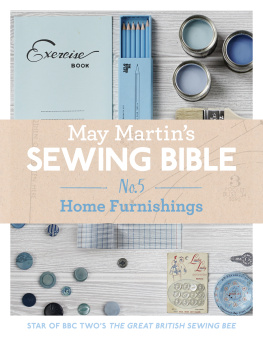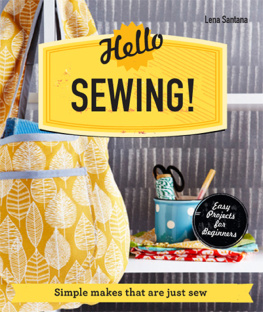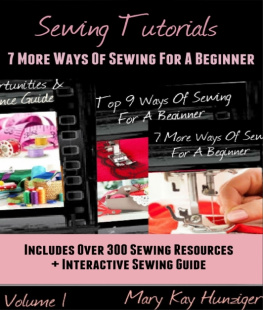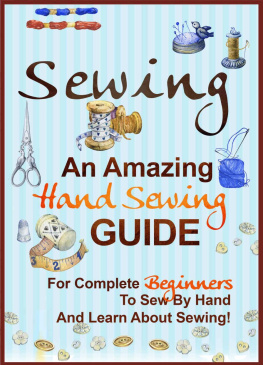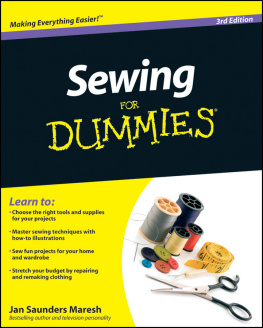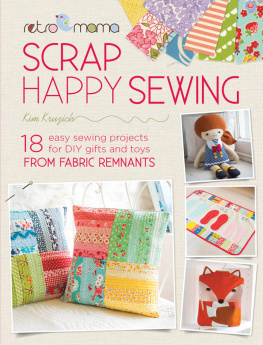THIS IS A BOOK on Sewing made easySewing made fun! It is based on time-saving ideas.
The author, Constance Talbot, was a small girl when she first learned to sew. As she grew older she quickly became impatient with time-wasting Victorian sewing traditionsbecame too busy to labor long over a costume that required weeks of work when the same effect could be developed in a few hours with the aid of short-cuts.
In her business career with overflowing hours of work she has kept house and sewed successfully because she streamlined her routine to the shortest quickest timing.
The great modern American Dressmakers are among her close friends and from them she has learned much about efficiency in professional sewing. With countless housewives she has, during her nation-wide lecture tours and sewing demonstrations, exchanged tested short cuts.
Many of these time saving ideas and methods are included in this book to help both beginner and expert to discover that it is truly fun to sew.
Whatever your skill, whatever your interest in sewing, you will find the answers to your questions in this book. Use the Ready Reference Guide at the back freely, as you would the index of a cookbook. What is the easiest placket to make? How do you make a bound pocket? How many curtain poles are needed? What yardage is needed for a chair cover? The Ready Reference Guide will quickly point you to the answer.
ACKNOWLEDGEMENTS
GRATITUDE is due to the following organizations who permitted reproduction of certain copyrighted photographs owned by them:
American Bemberg Corporation; American Viscose Corporation, sponsors of Crown Tested Rayon Fabrics; The Makers of Armstrongs Linoleum; John Barr; Bernside Mills; Bigelow-Sanford Carpet Co., Inc.; Bureau of Fashion Trends; Charm Magazine; Congoleum-Nairn, Inc.; Cordurella; Dennison Klothes, Inc.; Andres Feininger, courtesy Life Magazine; Galey & Lord, Inc.; Good Housekeeping Magazine; Hollywood Patterns; LaMode Buttons; New York Times Studio; Old Hickory Furniture; Pacific Factag Fabrics; Paragon Quilts; Quaker Lace Company; Simplicity Pattern Company, Inc.; W. & J. Sloane; The Spool Cotton Company; Tebilized Crush Resistance; Tennessee Eastman Corporation; Waverly Fabrics; Womans Day Magazine.
The Photographs and sketches on are copyrighted by Conde Nast Publications, Inc. Illustrations of attachments for sewing machines and the jacket illustration are copyrighted by Singer Sewing Machine Company. Special acknowledgement is due Vivian Seminary for her fashion illustrations.
CONTENTS
Simple rules for the selection of clothes. What is basic style? Choosing colors best suited to skin tones, color of hair and eyesto personalityto figure. Emphasizing good points.
Correlating fabric to style and pattern. Choosing the best type of pattern for printed, novelty, smooth surface, luxury, staple and utility fabrics. What are cold weather, warm weather coat fabrics? Fabrics best suited for underwear, bathrobes, utility or luxury underwear. Lining fabrics. Interlinings and their uses. How to choose the right fabric for a pattern with ruffles, pleats, darts, or gathers. Important facts about fabricsthe fibers, yarns and weaves that go into them. What is color fastness? What causes shrinkage? How to shrink fabric. New fabric finishescrease-resisting, permanent stiffening, sanforizing and sanitary finishes.
Having the right tools at the right time. How to care for them, when to use them. Needle and thread chart.
Simple rules for salvaging and saving sewing materials.
Eleven different fundamental stitches and their uses for hand and machine sewing such as blind hemming, slip-stitch, running stitch, gathering stitches; learning to stitch by machine.
Seam allowances, seams for straight and bias edges, for transparent, heavy and napped fabrics. How to ease in fullness. Joined seams, welt seams, covered seams, taped and bound seams. French seams, decorative seams, upholsterers seams. How to turn corners in a seam. Square corners.
Fitting darts, plain darts. Darts to hold fullness and to give fullness. How to measure for tucks. Hand and machine tucks. Straight, side, box, inverted, accordion and kick pleats. Contrasting color in pleats. How to insert godets.
Hand and machine gatherings, hand shirring. How to set gathersto shape an edge, to control fullness. How to estimate fullness. How to make headings, ruffles, casings, corners in lace and lace joinings. Machine-embroidered insertions and edgings. Passementeries.
Importance of machine and hand hems, blind and slip-stitched hems. Underwear hems, shell, hand-rolled, circular and curved edge hems. Picot, taped and catch stitched hems. Pleated skirt and napery hems. Decorative hems, Facings and their uses. Double, straight and band facings. Applied trimming bands, mitred corners, banding a square neck. Facing scallops, binding edges, straight bindings, binding a square corner, braid, bias, double bias, and French binding.
Embroidery stitches, chain, couching, satin, lazy-daisy, feather, blanket, cross stitch, bullion and seed stitch. Beading, eyelets, scallops, appliqu quilting, trapunto quilting, smocking, honeycomb, seed, diamond and cable smocking. Bar. French criss-cross, ribbon and machine fagoting. Hemstitching. Tassels, pom-poms and fringe. Designs to trace.
Where to take bustline, waistline and hip measurements. Charts and explanations. Six steps to successful clothes. Time-saving feature in making your dress. Step by step routine, from laying out the pattern to the completed garment.
How to alter patterns, make patterns longer, shorter, narrower, and wider. Adjusting sleeves, and shoulders, for sloping, rounded, wide, narrow and square shoulders. Large and small arms. Large abdomens and hipsflat and full busts. Sway backs.
Preparations and cutting routine. What the pattern markings mean. How to transfer them. How to cut plaids, figured materials, large checks, up and down prints, stripes. Patterns for cutting gilets, blouses, panties and brassieres.
Different types of basting and their uses. Step by step order of basting. Removing basting stitches.
How to adjust side seams, wide or narrow shoulders. How to fit sleeves. How to adjust necklines, collars waistlines and hips.
Classic, corded and revere neck lines. Stitched, overlaid transparent, decorative and detachable yokes. Jabots and scarves.
Double scarf, jabot, stiffened, single, straight, sailor and coat collars. How to apply and make them. Classic, convertible dickies and vests. Patterns for cutting.
How to cut, construct and pin sleeves and armholes. Puffed, raglan, tailored sleeves. How, when and where to join shoulder seams. When are armholes bound. What kind of shoulder pads to use, what type of fabrics to use. How to shrink and press sleeves. Cuff finishes. Finishes for gathered sleeves, fitted sleeves.
Set-in belts, drawstring belts. How to make separate skirtsskirts with inner belting. Separate belts. Where to use and how to make plackets. How to make a pleated or gathered skirt, skirt with yoke. How to hang a skirt. Three different ways of marking your hem-line without the aid of a fitter. How to hang a circular skirt; how to adjust and remove bagginess from a skirt.
Closings for tailored clothes, for decorative effects. How to sew in all types of sewing fasteners, classic, covered, shank-stem, linked buttons and buttons held with fabric. How to make buttonholes, tailored buttonholesbound buttonholes. How to make buttonhole loopshow to apply loop fastenings. How to make corded tubing loops, cord motifs and bow-tie closings. How to insert zippers, in a seam, in a faced edge, under a band, in a fly placket.


